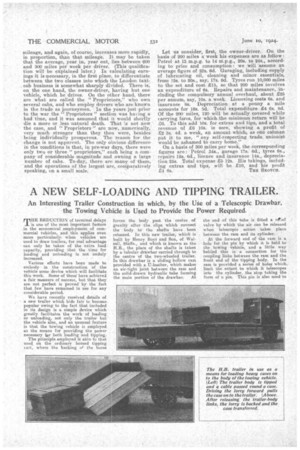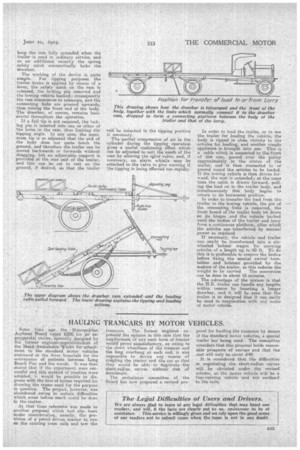A NEW SELF-LOADING AND TIPPING TRAILER.
Page 28

Page 29

If you've noticed an error in this article please click here to report it so we can fix it.
An Interesting Trailer Construction in which, by the Use of a Telescopic Drawbar, the Towing Vehicle is Used to Provide the Power Required.
THE REDUCTION of terminal delays is one of the most important factors in the economical employment, of commercial vehicles, and this applies even more particularly, when vehicles are used to draw trailers, for real advantage can only be taken of the extra load capacity, providing that the time for loading and unloading is net unduly increased.
Various efforts have been made to embody in the construction of the vehicle some 'device which will facilitate this work. Some of these have achieved a fair measure of success, but that they are not perfect is proved" by the fact that. few have remained in use for any considerable period.
We have recently .received details of a new trailer which bids fair to become popular owing to the fact that included in its design is a simple device which greatly facilitates the work of loading or unloading, not only the trailer but the vehicle also, and an unusual feature is that the towing vehicle is emPloyed as the means for providing the power necessary for both loading and tipping.
The principle employed is akin to that used on the ordinary horsed tipping cart, where the backing oF the horse
forces the body past the centre of gravity after the clips which connect the body to the shafts have been released. In this new trailer, which is built by Henry Boys and Son, of Walsall, Staffs., and which is known as the H.B.' the plate of the shafts is taken by a tubular drawbar carried through to the centre of the two-wheeled trailer. In this drawbar is a sliding hollow ram provided with a U-leather, which makes an air-tight joint between the ram and the solid-drawn hydraulic tube forming the main portion of the drawbar. At the end of this tube is fitted a reief valve by which the air can be released when telescopic action takes place between the ram and its cylinder.
At the forward end of the ram is a hole for the pin by which it is held to the towing vehicle, and a little way behind this is a connection for the coupling links between the rani and the front end of the tipping body. In the ram is provided a series of holes which, limit the extent to which it telescopes into the cylinder, the stop taking the form of a pin. This pin is also used to
keep the ram fully extended when the trailer is used in ordinary service, and as an additional security the spring safety catch automatically locks the drawbar.
The working of the device is quite simple. For tipping purposes the trailer brake is applied by means of a lever, the safety catch on the ram is eleased, the locking pin removed and the towing vehicle backed; consequently the ram commences to telescope, and the connecting links are pressed upwards, thus raising the front end of the body. The drawbar, of course, remains horizontal throughout the operation. If a full tip is not required, the locking pin is inserted into one or other of the holes in the ram, thus limiting the tipping angle. In any case, the maximum tip is so adjusted that the end of the body does not quite touch the ground, and therefore the trailer can be moved backwards or forwards without dragging, but an adjustable support is provided at the rear end of the trailer, and this can be set to rest on the ground, if desired, so that the trailer -ea‘ be detached in the tipping position it necessary.
The partial compression of air in the cylinder during the tipping operation gives a useful cushioning effect which can be adjusted to suit the needs of the user by altering the relief valve, and, if necessary, an alarm whistle may be attached to the valve to give warning if the tipping is being effected too rapidly.
In order to load the trailer, or to use the trailer for loading the vehicle, the body is tipped in close vicinity to the articles for loading, and another simple appliance is brought into use. This is a cable which is connected to the front of the ram, passed over the pulley approximately in the centre of the trailer' • and is then connected to or passed round the articles to be loaded. If the towing vehicle is then driven foryard, the ram is extended; at the same time the cable is drawn forward, pulling the load on to the trailer body, and simultaneously this body begins to return to its horizontal position.
In order to transfer the lead from the trailer to the towing vehicle, the pin of the connecting links is removed, the front board of the trailer body let down on its hinges, and the vehicle hacked until the bodies of the trailer and lorry form a continuous platform, after which the articles are transferred by manual power as required
If necessary, the vehicle and trailer can easily be transformed into a six-wheeled holster wagon for carrying articles of a length up to 60 ft. To do this it-is preferable to remove the bodies before fixing the special swivel turntables and bolsters provided by the makers of the trailer, as this reduces the weight to be carried. The conversion can be done in about 15 minutes.
The advantage of the system is that the H.B. trailer can handle any lengths within reason by inserting a longer drawbar, and it will be seen that the trailer is so designed that it can easily be used in -conjunction with any Make of motor vehicle.
































